Marketing Essentials: Analyzing Role, 7Ps & Basic Marketing Plan
VerifiedAdded on 2023/01/06
|15
|3405
|86
Report
AI Summary
This report provides a comprehensive overview of marketing essentials, focusing on the role of marketing within an organization and its interrelation with other functional units. It examines how companies like Nike and Adidas utilize the 7Ps of the marketing mix (Product, Price, Place, Promotion, People, Processes, and Physical Evidence) to achieve their overall business objectives. The report also develops and evaluates a basic marketing plan, highlighting the importance and value of such plans in providing a blueprint for the organization, maintaining accountability, aligning with vision and goals, and evaluating new opportunities. The analysis includes specific examples from Nike's marketing strategies and compares them with those of Adidas, offering a detailed understanding of how marketing principles are applied in practice. Desklib offers a range of solved assignments and study tools for students.

Unit 2
Marketing Essentials
Student`s Name:
Student`s ID:
1
Marketing Essentials
Student`s Name:
Student`s ID:
1
Paraphrase This Document
Need a fresh take? Get an instant paraphrase of this document with our AI Paraphraser
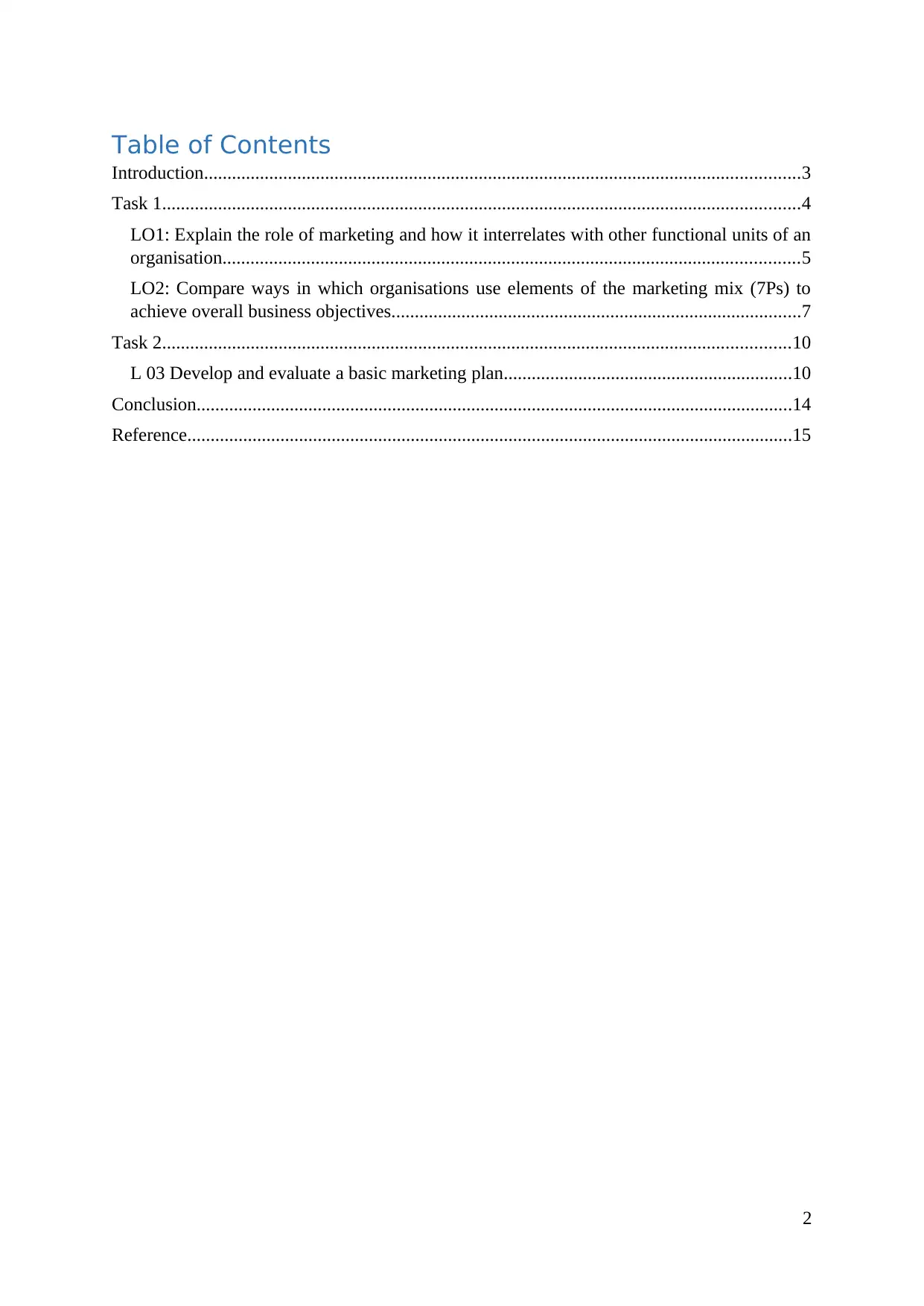
Table of Contents
Introduction................................................................................................................................3
Task 1.........................................................................................................................................4
LO1: Explain the role of marketing and how it interrelates with other functional units of an
organisation............................................................................................................................5
LO2: Compare ways in which organisations use elements of the marketing mix (7Ps) to
achieve overall business objectives........................................................................................7
Task 2.......................................................................................................................................10
L 03 Develop and evaluate a basic marketing plan..............................................................10
Conclusion................................................................................................................................14
Reference..................................................................................................................................15
2
Introduction................................................................................................................................3
Task 1.........................................................................................................................................4
LO1: Explain the role of marketing and how it interrelates with other functional units of an
organisation............................................................................................................................5
LO2: Compare ways in which organisations use elements of the marketing mix (7Ps) to
achieve overall business objectives........................................................................................7
Task 2.......................................................................................................................................10
L 03 Develop and evaluate a basic marketing plan..............................................................10
Conclusion................................................................................................................................14
Reference..................................................................................................................................15
2
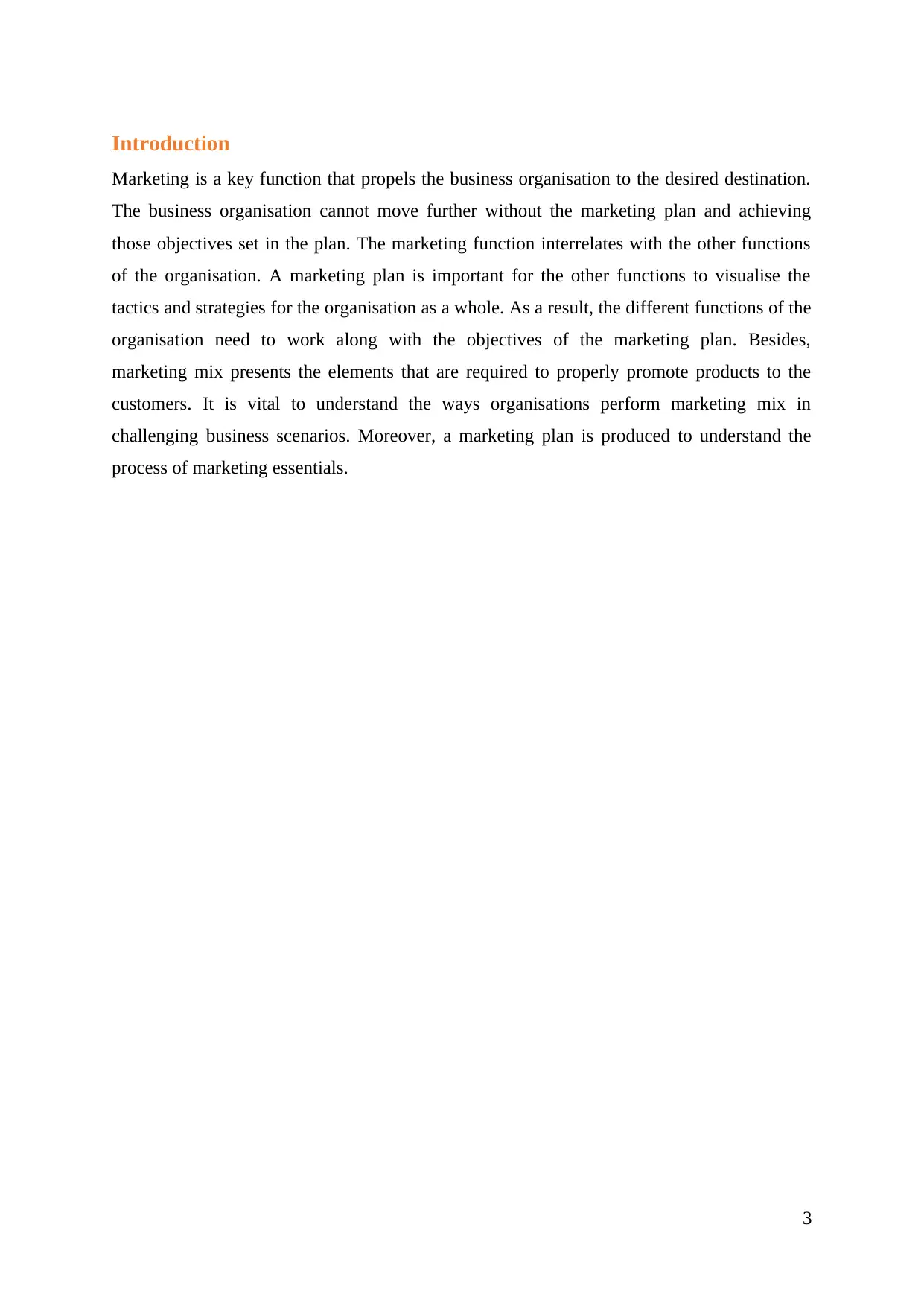
Introduction
Marketing is a key function that propels the business organisation to the desired destination.
The business organisation cannot move further without the marketing plan and achieving
those objectives set in the plan. The marketing function interrelates with the other functions
of the organisation. A marketing plan is important for the other functions to visualise the
tactics and strategies for the organisation as a whole. As a result, the different functions of the
organisation need to work along with the objectives of the marketing plan. Besides,
marketing mix presents the elements that are required to properly promote products to the
customers. It is vital to understand the ways organisations perform marketing mix in
challenging business scenarios. Moreover, a marketing plan is produced to understand the
process of marketing essentials.
3
Marketing is a key function that propels the business organisation to the desired destination.
The business organisation cannot move further without the marketing plan and achieving
those objectives set in the plan. The marketing function interrelates with the other functions
of the organisation. A marketing plan is important for the other functions to visualise the
tactics and strategies for the organisation as a whole. As a result, the different functions of the
organisation need to work along with the objectives of the marketing plan. Besides,
marketing mix presents the elements that are required to properly promote products to the
customers. It is vital to understand the ways organisations perform marketing mix in
challenging business scenarios. Moreover, a marketing plan is produced to understand the
process of marketing essentials.
3
⊘ This is a preview!⊘
Do you want full access?
Subscribe today to unlock all pages.

Trusted by 1+ million students worldwide
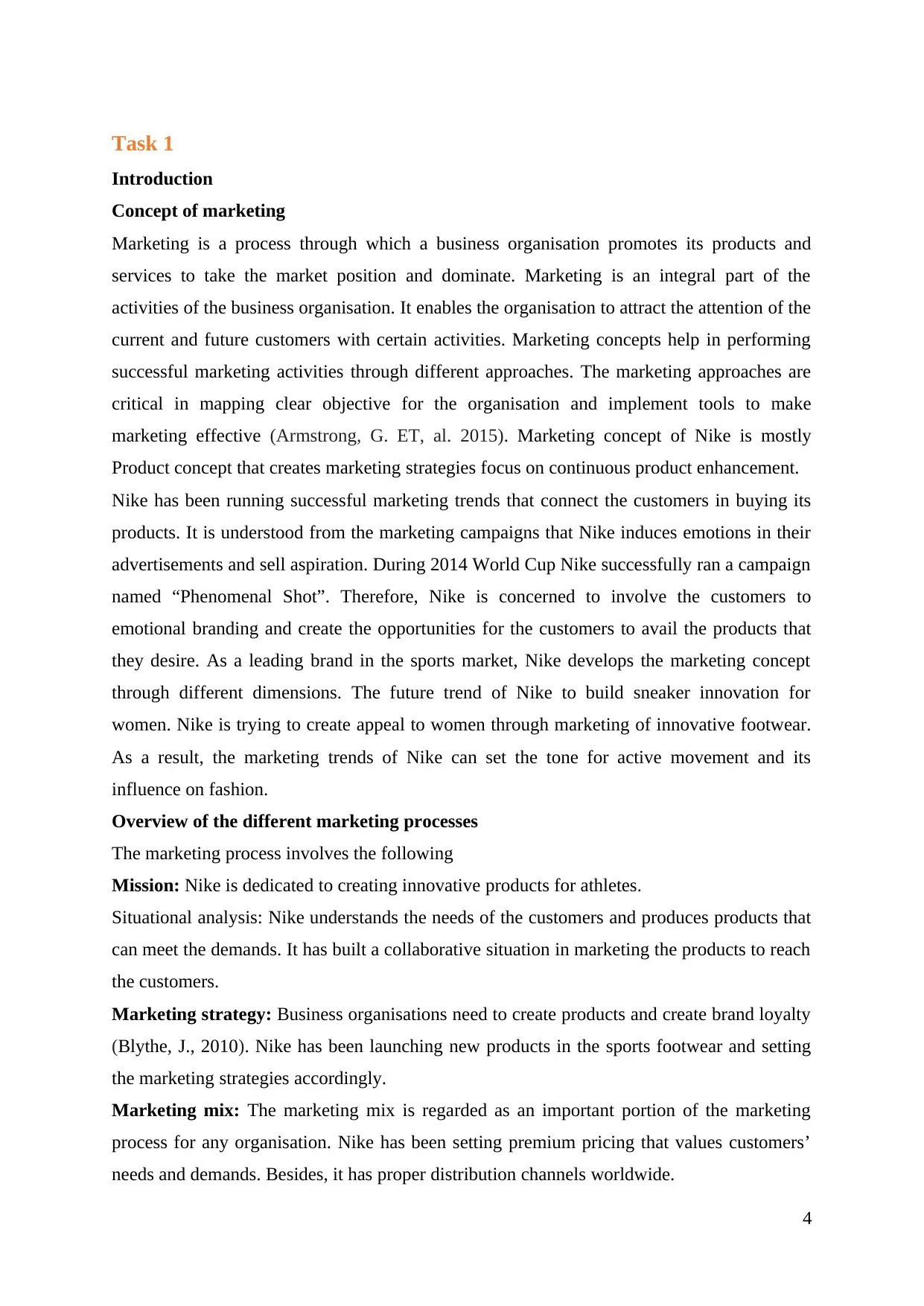
Task 1
Introduction
Concept of marketing
Marketing is a process through which a business organisation promotes its products and
services to take the market position and dominate. Marketing is an integral part of the
activities of the business organisation. It enables the organisation to attract the attention of the
current and future customers with certain activities. Marketing concepts help in performing
successful marketing activities through different approaches. The marketing approaches are
critical in mapping clear objective for the organisation and implement tools to make
marketing effective (Armstrong, G. ET, al. 2015). Marketing concept of Nike is mostly
Product concept that creates marketing strategies focus on continuous product enhancement.
Nike has been running successful marketing trends that connect the customers in buying its
products. It is understood from the marketing campaigns that Nike induces emotions in their
advertisements and sell aspiration. During 2014 World Cup Nike successfully ran a campaign
named “Phenomenal Shot”. Therefore, Nike is concerned to involve the customers to
emotional branding and create the opportunities for the customers to avail the products that
they desire. As a leading brand in the sports market, Nike develops the marketing concept
through different dimensions. The future trend of Nike to build sneaker innovation for
women. Nike is trying to create appeal to women through marketing of innovative footwear.
As a result, the marketing trends of Nike can set the tone for active movement and its
influence on fashion.
Overview of the different marketing processes
The marketing process involves the following
Mission: Nike is dedicated to creating innovative products for athletes.
Situational analysis: Nike understands the needs of the customers and produces products that
can meet the demands. It has built a collaborative situation in marketing the products to reach
the customers.
Marketing strategy: Business organisations need to create products and create brand loyalty
(Blythe, J., 2010). Nike has been launching new products in the sports footwear and setting
the marketing strategies accordingly.
Marketing mix: The marketing mix is regarded as an important portion of the marketing
process for any organisation. Nike has been setting premium pricing that values customers’
needs and demands. Besides, it has proper distribution channels worldwide.
4
Introduction
Concept of marketing
Marketing is a process through which a business organisation promotes its products and
services to take the market position and dominate. Marketing is an integral part of the
activities of the business organisation. It enables the organisation to attract the attention of the
current and future customers with certain activities. Marketing concepts help in performing
successful marketing activities through different approaches. The marketing approaches are
critical in mapping clear objective for the organisation and implement tools to make
marketing effective (Armstrong, G. ET, al. 2015). Marketing concept of Nike is mostly
Product concept that creates marketing strategies focus on continuous product enhancement.
Nike has been running successful marketing trends that connect the customers in buying its
products. It is understood from the marketing campaigns that Nike induces emotions in their
advertisements and sell aspiration. During 2014 World Cup Nike successfully ran a campaign
named “Phenomenal Shot”. Therefore, Nike is concerned to involve the customers to
emotional branding and create the opportunities for the customers to avail the products that
they desire. As a leading brand in the sports market, Nike develops the marketing concept
through different dimensions. The future trend of Nike to build sneaker innovation for
women. Nike is trying to create appeal to women through marketing of innovative footwear.
As a result, the marketing trends of Nike can set the tone for active movement and its
influence on fashion.
Overview of the different marketing processes
The marketing process involves the following
Mission: Nike is dedicated to creating innovative products for athletes.
Situational analysis: Nike understands the needs of the customers and produces products that
can meet the demands. It has built a collaborative situation in marketing the products to reach
the customers.
Marketing strategy: Business organisations need to create products and create brand loyalty
(Blythe, J., 2010). Nike has been launching new products in the sports footwear and setting
the marketing strategies accordingly.
Marketing mix: The marketing mix is regarded as an important portion of the marketing
process for any organisation. Nike has been setting premium pricing that values customers’
needs and demands. Besides, it has proper distribution channels worldwide.
4
Paraphrase This Document
Need a fresh take? Get an instant paraphrase of this document with our AI Paraphraser
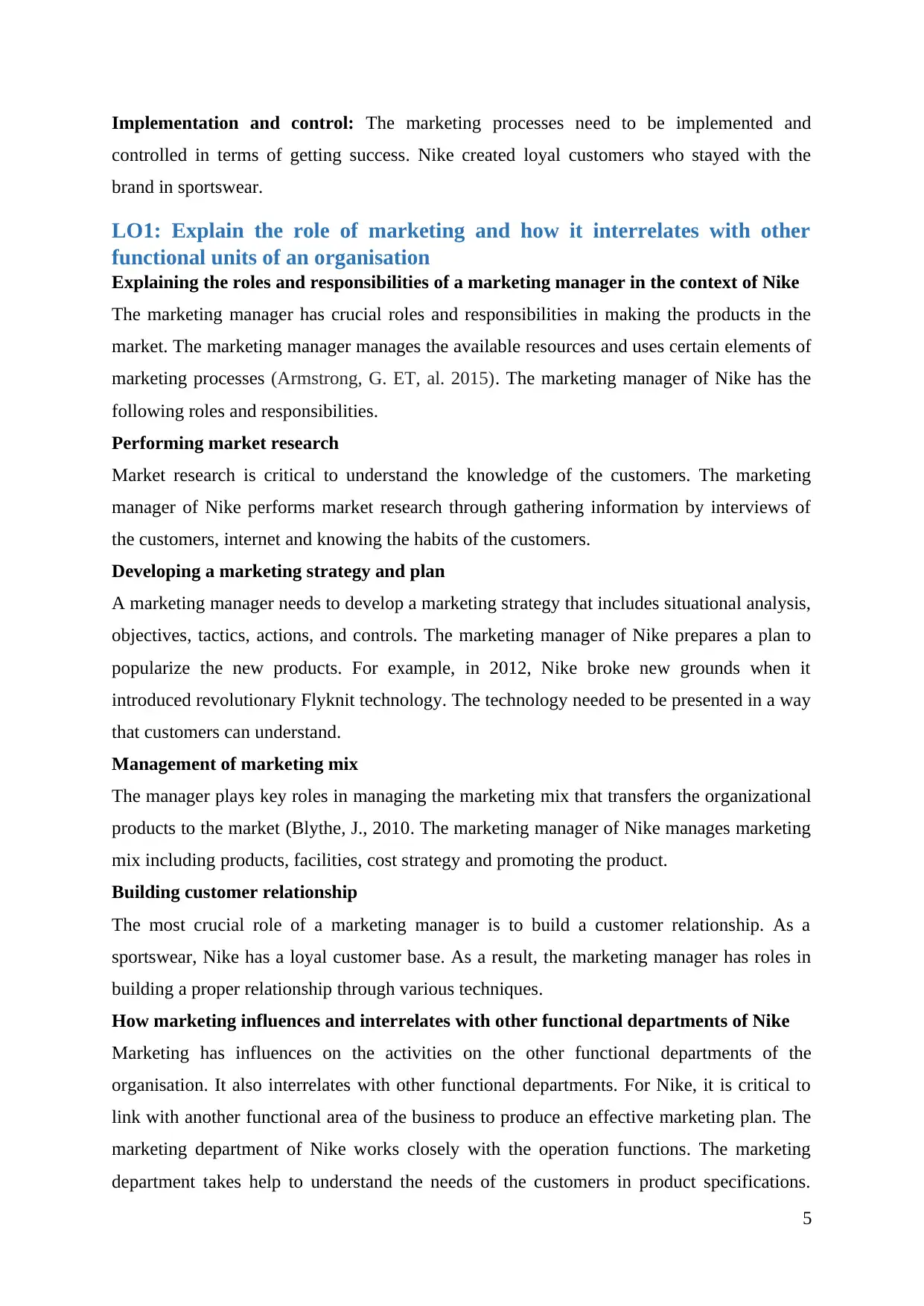
Implementation and control: The marketing processes need to be implemented and
controlled in terms of getting success. Nike created loyal customers who stayed with the
brand in sportswear.
LO1: Explain the role of marketing and how it interrelates with other
functional units of an organisation
Explaining the roles and responsibilities of a marketing manager in the context of Nike
The marketing manager has crucial roles and responsibilities in making the products in the
market. The marketing manager manages the available resources and uses certain elements of
marketing processes (Armstrong, G. ET, al. 2015). The marketing manager of Nike has the
following roles and responsibilities.
Performing market research
Market research is critical to understand the knowledge of the customers. The marketing
manager of Nike performs market research through gathering information by interviews of
the customers, internet and knowing the habits of the customers.
Developing a marketing strategy and plan
A marketing manager needs to develop a marketing strategy that includes situational analysis,
objectives, tactics, actions, and controls. The marketing manager of Nike prepares a plan to
popularize the new products. For example, in 2012, Nike broke new grounds when it
introduced revolutionary Flyknit technology. The technology needed to be presented in a way
that customers can understand.
Management of marketing mix
The manager plays key roles in managing the marketing mix that transfers the organizational
products to the market (Blythe, J., 2010. The marketing manager of Nike manages marketing
mix including products, facilities, cost strategy and promoting the product.
Building customer relationship
The most crucial role of a marketing manager is to build a customer relationship. As a
sportswear, Nike has a loyal customer base. As a result, the marketing manager has roles in
building a proper relationship through various techniques.
How marketing influences and interrelates with other functional departments of Nike
Marketing has influences on the activities on the other functional departments of the
organisation. It also interrelates with other functional departments. For Nike, it is critical to
link with another functional area of the business to produce an effective marketing plan. The
marketing department of Nike works closely with the operation functions. The marketing
department takes help to understand the needs of the customers in product specifications.
5
controlled in terms of getting success. Nike created loyal customers who stayed with the
brand in sportswear.
LO1: Explain the role of marketing and how it interrelates with other
functional units of an organisation
Explaining the roles and responsibilities of a marketing manager in the context of Nike
The marketing manager has crucial roles and responsibilities in making the products in the
market. The marketing manager manages the available resources and uses certain elements of
marketing processes (Armstrong, G. ET, al. 2015). The marketing manager of Nike has the
following roles and responsibilities.
Performing market research
Market research is critical to understand the knowledge of the customers. The marketing
manager of Nike performs market research through gathering information by interviews of
the customers, internet and knowing the habits of the customers.
Developing a marketing strategy and plan
A marketing manager needs to develop a marketing strategy that includes situational analysis,
objectives, tactics, actions, and controls. The marketing manager of Nike prepares a plan to
popularize the new products. For example, in 2012, Nike broke new grounds when it
introduced revolutionary Flyknit technology. The technology needed to be presented in a way
that customers can understand.
Management of marketing mix
The manager plays key roles in managing the marketing mix that transfers the organizational
products to the market (Blythe, J., 2010. The marketing manager of Nike manages marketing
mix including products, facilities, cost strategy and promoting the product.
Building customer relationship
The most crucial role of a marketing manager is to build a customer relationship. As a
sportswear, Nike has a loyal customer base. As a result, the marketing manager has roles in
building a proper relationship through various techniques.
How marketing influences and interrelates with other functional departments of Nike
Marketing has influences on the activities on the other functional departments of the
organisation. It also interrelates with other functional departments. For Nike, it is critical to
link with another functional area of the business to produce an effective marketing plan. The
marketing department of Nike works closely with the operation functions. The marketing
department takes help to understand the needs of the customers in product specifications.
5
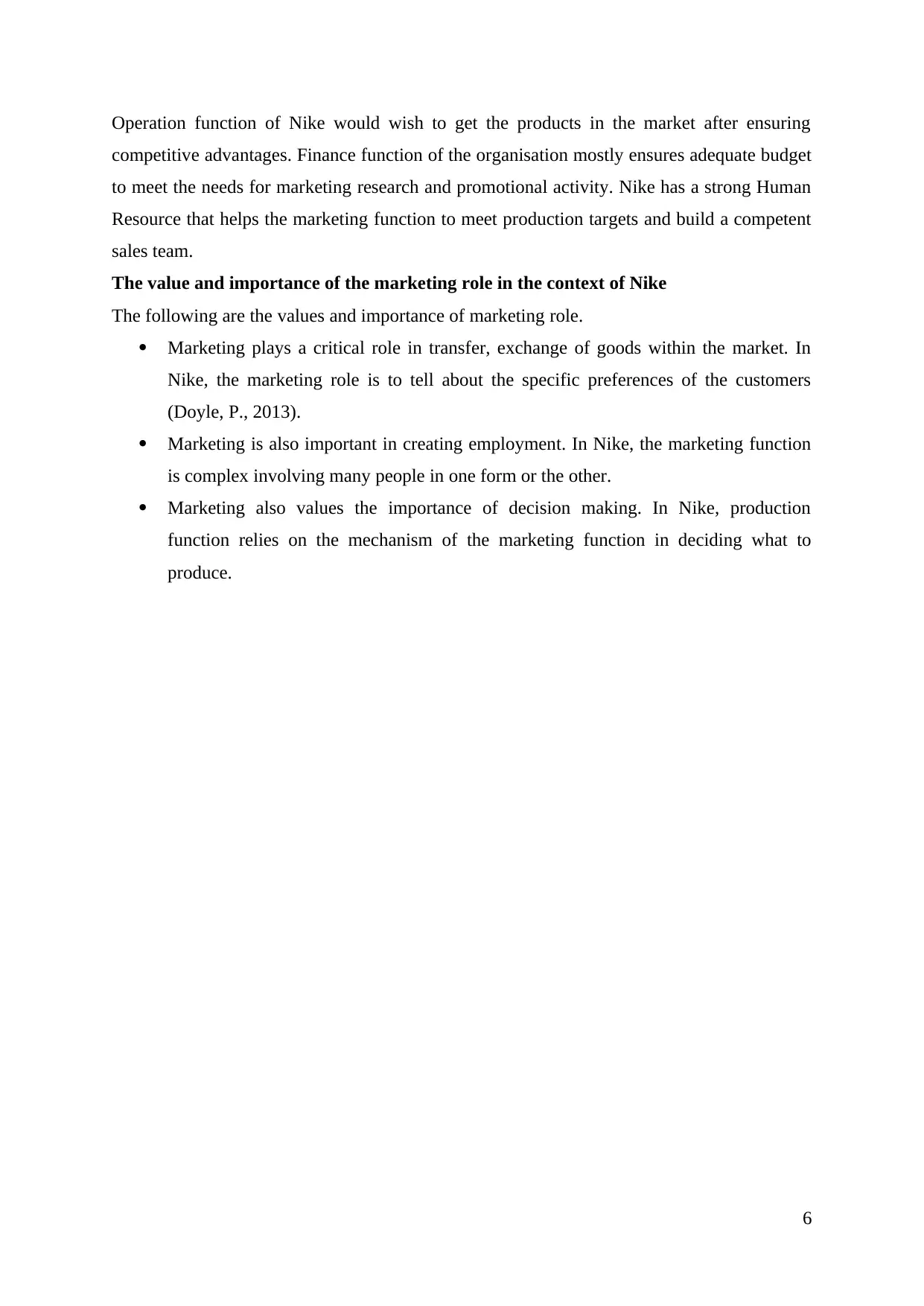
Operation function of Nike would wish to get the products in the market after ensuring
competitive advantages. Finance function of the organisation mostly ensures adequate budget
to meet the needs for marketing research and promotional activity. Nike has a strong Human
Resource that helps the marketing function to meet production targets and build a competent
sales team.
The value and importance of the marketing role in the context of Nike
The following are the values and importance of marketing role.
Marketing plays a critical role in transfer, exchange of goods within the market. In
Nike, the marketing role is to tell about the specific preferences of the customers
(Doyle, P., 2013).
Marketing is also important in creating employment. In Nike, the marketing function
is complex involving many people in one form or the other.
Marketing also values the importance of decision making. In Nike, production
function relies on the mechanism of the marketing function in deciding what to
produce.
6
competitive advantages. Finance function of the organisation mostly ensures adequate budget
to meet the needs for marketing research and promotional activity. Nike has a strong Human
Resource that helps the marketing function to meet production targets and build a competent
sales team.
The value and importance of the marketing role in the context of Nike
The following are the values and importance of marketing role.
Marketing plays a critical role in transfer, exchange of goods within the market. In
Nike, the marketing role is to tell about the specific preferences of the customers
(Doyle, P., 2013).
Marketing is also important in creating employment. In Nike, the marketing function
is complex involving many people in one form or the other.
Marketing also values the importance of decision making. In Nike, production
function relies on the mechanism of the marketing function in deciding what to
produce.
6
⊘ This is a preview!⊘
Do you want full access?
Subscribe today to unlock all pages.

Trusted by 1+ million students worldwide
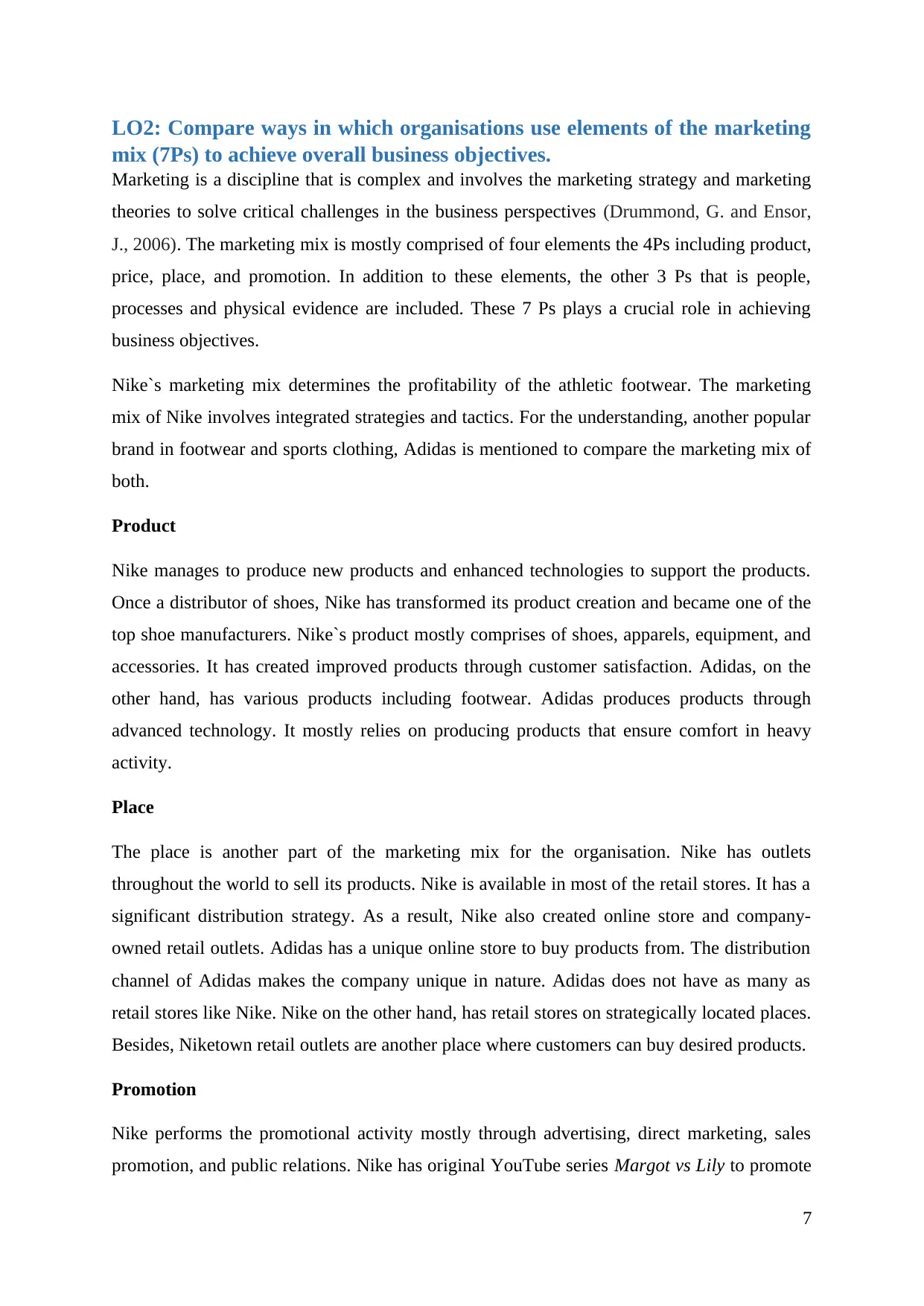
LO2: Compare ways in which organisations use elements of the marketing
mix (7Ps) to achieve overall business objectives.
Marketing is a discipline that is complex and involves the marketing strategy and marketing
theories to solve critical challenges in the business perspectives (Drummond, G. and Ensor,
J., 2006). The marketing mix is mostly comprised of four elements the 4Ps including product,
price, place, and promotion. In addition to these elements, the other 3 Ps that is people,
processes and physical evidence are included. These 7 Ps plays a crucial role in achieving
business objectives.
Nike`s marketing mix determines the profitability of the athletic footwear. The marketing
mix of Nike involves integrated strategies and tactics. For the understanding, another popular
brand in footwear and sports clothing, Adidas is mentioned to compare the marketing mix of
both.
Product
Nike manages to produce new products and enhanced technologies to support the products.
Once a distributor of shoes, Nike has transformed its product creation and became one of the
top shoe manufacturers. Nike`s product mostly comprises of shoes, apparels, equipment, and
accessories. It has created improved products through customer satisfaction. Adidas, on the
other hand, has various products including footwear. Adidas produces products through
advanced technology. It mostly relies on producing products that ensure comfort in heavy
activity.
Place
The place is another part of the marketing mix for the organisation. Nike has outlets
throughout the world to sell its products. Nike is available in most of the retail stores. It has a
significant distribution strategy. As a result, Nike also created online store and company-
owned retail outlets. Adidas has a unique online store to buy products from. The distribution
channel of Adidas makes the company unique in nature. Adidas does not have as many as
retail stores like Nike. Nike on the other hand, has retail stores on strategically located places.
Besides, Niketown retail outlets are another place where customers can buy desired products.
Promotion
Nike performs the promotional activity mostly through advertising, direct marketing, sales
promotion, and public relations. Nike has original YouTube series Margot vs Lily to promote
7
mix (7Ps) to achieve overall business objectives.
Marketing is a discipline that is complex and involves the marketing strategy and marketing
theories to solve critical challenges in the business perspectives (Drummond, G. and Ensor,
J., 2006). The marketing mix is mostly comprised of four elements the 4Ps including product,
price, place, and promotion. In addition to these elements, the other 3 Ps that is people,
processes and physical evidence are included. These 7 Ps plays a crucial role in achieving
business objectives.
Nike`s marketing mix determines the profitability of the athletic footwear. The marketing
mix of Nike involves integrated strategies and tactics. For the understanding, another popular
brand in footwear and sports clothing, Adidas is mentioned to compare the marketing mix of
both.
Product
Nike manages to produce new products and enhanced technologies to support the products.
Once a distributor of shoes, Nike has transformed its product creation and became one of the
top shoe manufacturers. Nike`s product mostly comprises of shoes, apparels, equipment, and
accessories. It has created improved products through customer satisfaction. Adidas, on the
other hand, has various products including footwear. Adidas produces products through
advanced technology. It mostly relies on producing products that ensure comfort in heavy
activity.
Place
The place is another part of the marketing mix for the organisation. Nike has outlets
throughout the world to sell its products. Nike is available in most of the retail stores. It has a
significant distribution strategy. As a result, Nike also created online store and company-
owned retail outlets. Adidas has a unique online store to buy products from. The distribution
channel of Adidas makes the company unique in nature. Adidas does not have as many as
retail stores like Nike. Nike on the other hand, has retail stores on strategically located places.
Besides, Niketown retail outlets are another place where customers can buy desired products.
Promotion
Nike performs the promotional activity mostly through advertising, direct marketing, sales
promotion, and public relations. Nike has original YouTube series Margot vs Lily to promote
7
Paraphrase This Document
Need a fresh take? Get an instant paraphrase of this document with our AI Paraphraser
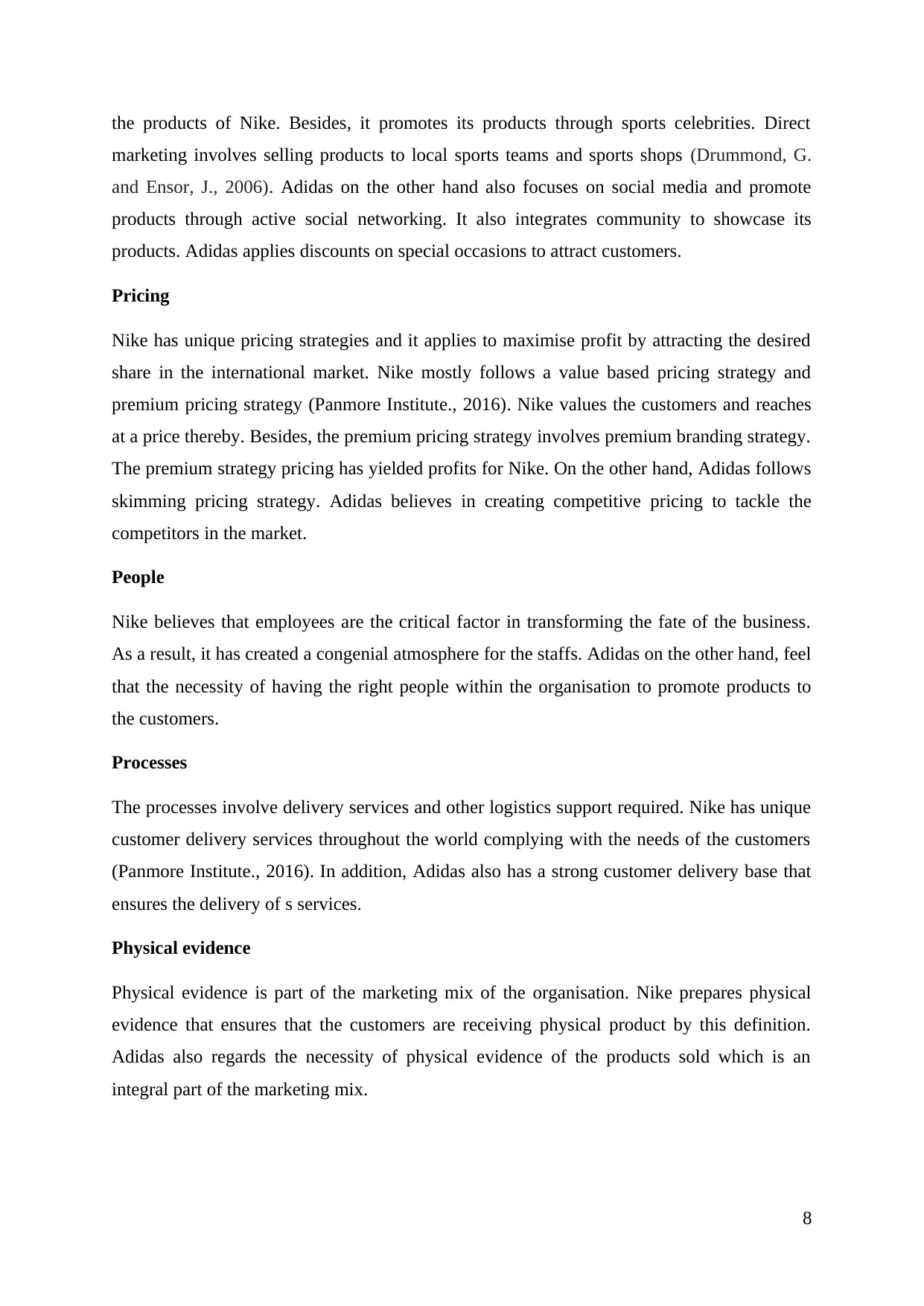
the products of Nike. Besides, it promotes its products through sports celebrities. Direct
marketing involves selling products to local sports teams and sports shops (Drummond, G.
and Ensor, J., 2006). Adidas on the other hand also focuses on social media and promote
products through active social networking. It also integrates community to showcase its
products. Adidas applies discounts on special occasions to attract customers.
Pricing
Nike has unique pricing strategies and it applies to maximise profit by attracting the desired
share in the international market. Nike mostly follows a value based pricing strategy and
premium pricing strategy (Panmore Institute., 2016). Nike values the customers and reaches
at a price thereby. Besides, the premium pricing strategy involves premium branding strategy.
The premium strategy pricing has yielded profits for Nike. On the other hand, Adidas follows
skimming pricing strategy. Adidas believes in creating competitive pricing to tackle the
competitors in the market.
People
Nike believes that employees are the critical factor in transforming the fate of the business.
As a result, it has created a congenial atmosphere for the staffs. Adidas on the other hand, feel
that the necessity of having the right people within the organisation to promote products to
the customers.
Processes
The processes involve delivery services and other logistics support required. Nike has unique
customer delivery services throughout the world complying with the needs of the customers
(Panmore Institute., 2016). In addition, Adidas also has a strong customer delivery base that
ensures the delivery of s services.
Physical evidence
Physical evidence is part of the marketing mix of the organisation. Nike prepares physical
evidence that ensures that the customers are receiving physical product by this definition.
Adidas also regards the necessity of physical evidence of the products sold which is an
integral part of the marketing mix.
8
marketing involves selling products to local sports teams and sports shops (Drummond, G.
and Ensor, J., 2006). Adidas on the other hand also focuses on social media and promote
products through active social networking. It also integrates community to showcase its
products. Adidas applies discounts on special occasions to attract customers.
Pricing
Nike has unique pricing strategies and it applies to maximise profit by attracting the desired
share in the international market. Nike mostly follows a value based pricing strategy and
premium pricing strategy (Panmore Institute., 2016). Nike values the customers and reaches
at a price thereby. Besides, the premium pricing strategy involves premium branding strategy.
The premium strategy pricing has yielded profits for Nike. On the other hand, Adidas follows
skimming pricing strategy. Adidas believes in creating competitive pricing to tackle the
competitors in the market.
People
Nike believes that employees are the critical factor in transforming the fate of the business.
As a result, it has created a congenial atmosphere for the staffs. Adidas on the other hand, feel
that the necessity of having the right people within the organisation to promote products to
the customers.
Processes
The processes involve delivery services and other logistics support required. Nike has unique
customer delivery services throughout the world complying with the needs of the customers
(Panmore Institute., 2016). In addition, Adidas also has a strong customer delivery base that
ensures the delivery of s services.
Physical evidence
Physical evidence is part of the marketing mix of the organisation. Nike prepares physical
evidence that ensures that the customers are receiving physical product by this definition.
Adidas also regards the necessity of physical evidence of the products sold which is an
integral part of the marketing mix.
8

Conclusion
The different functions of the business organisation play an effective role in creating a
performance. The operation department, finance department, and human resource department
work with marketing function to yield better results for the organisation.
9
The different functions of the business organisation play an effective role in creating a
performance. The operation department, finance department, and human resource department
work with marketing function to yield better results for the organisation.
9
⊘ This is a preview!⊘
Do you want full access?
Subscribe today to unlock all pages.

Trusted by 1+ million students worldwide
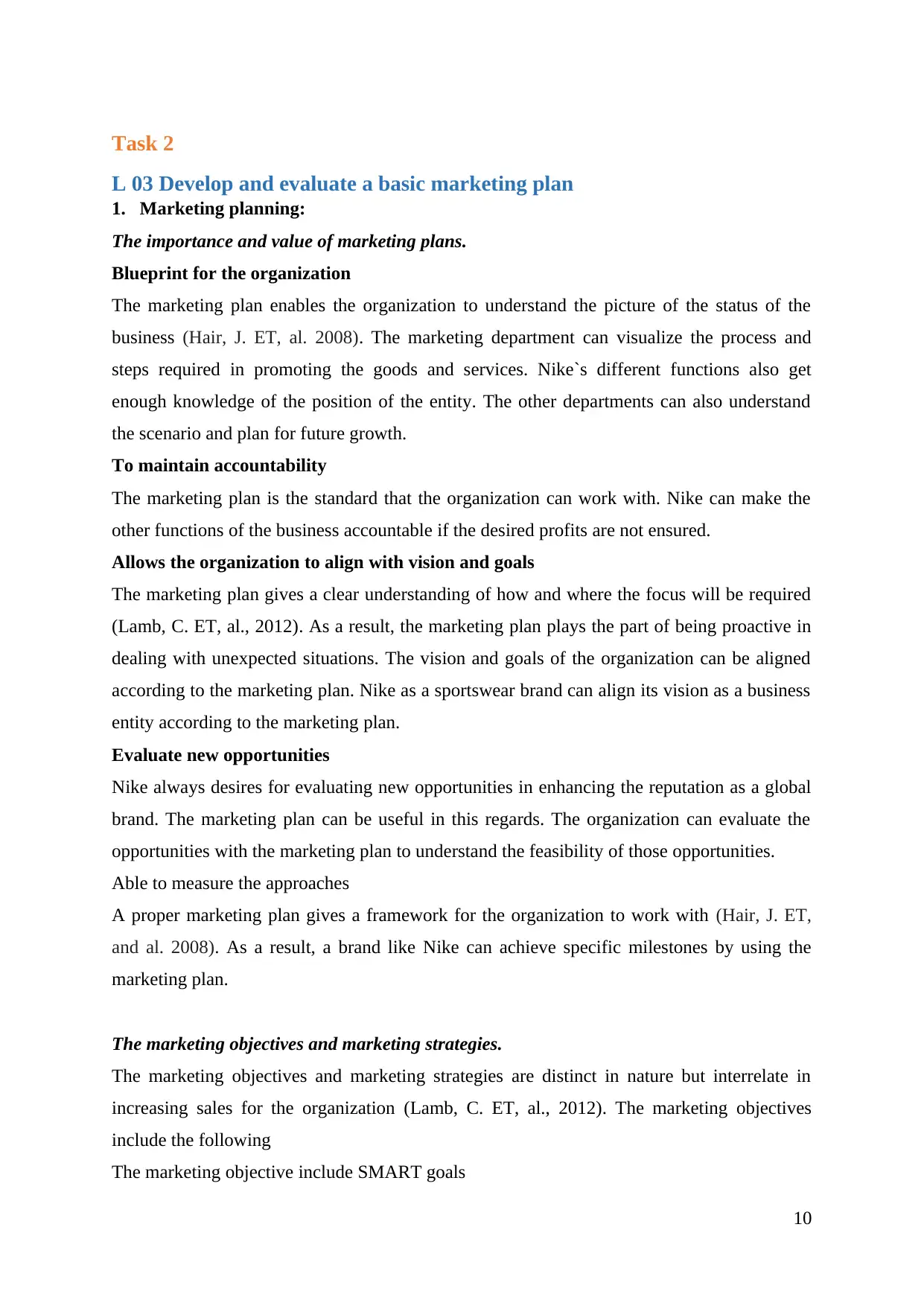
Task 2
L 03 Develop and evaluate a basic marketing plan
1. Marketing planning:
The importance and value of marketing plans.
Blueprint for the organization
The marketing plan enables the organization to understand the picture of the status of the
business (Hair, J. ET, al. 2008). The marketing department can visualize the process and
steps required in promoting the goods and services. Nike`s different functions also get
enough knowledge of the position of the entity. The other departments can also understand
the scenario and plan for future growth.
To maintain accountability
The marketing plan is the standard that the organization can work with. Nike can make the
other functions of the business accountable if the desired profits are not ensured.
Allows the organization to align with vision and goals
The marketing plan gives a clear understanding of how and where the focus will be required
(Lamb, C. ET, al., 2012). As a result, the marketing plan plays the part of being proactive in
dealing with unexpected situations. The vision and goals of the organization can be aligned
according to the marketing plan. Nike as a sportswear brand can align its vision as a business
entity according to the marketing plan.
Evaluate new opportunities
Nike always desires for evaluating new opportunities in enhancing the reputation as a global
brand. The marketing plan can be useful in this regards. The organization can evaluate the
opportunities with the marketing plan to understand the feasibility of those opportunities.
Able to measure the approaches
A proper marketing plan gives a framework for the organization to work with (Hair, J. ET,
and al. 2008). As a result, a brand like Nike can achieve specific milestones by using the
marketing plan.
The marketing objectives and marketing strategies.
The marketing objectives and marketing strategies are distinct in nature but interrelate in
increasing sales for the organization (Lamb, C. ET, al., 2012). The marketing objectives
include the following
The marketing objective include SMART goals
10
L 03 Develop and evaluate a basic marketing plan
1. Marketing planning:
The importance and value of marketing plans.
Blueprint for the organization
The marketing plan enables the organization to understand the picture of the status of the
business (Hair, J. ET, al. 2008). The marketing department can visualize the process and
steps required in promoting the goods and services. Nike`s different functions also get
enough knowledge of the position of the entity. The other departments can also understand
the scenario and plan for future growth.
To maintain accountability
The marketing plan is the standard that the organization can work with. Nike can make the
other functions of the business accountable if the desired profits are not ensured.
Allows the organization to align with vision and goals
The marketing plan gives a clear understanding of how and where the focus will be required
(Lamb, C. ET, al., 2012). As a result, the marketing plan plays the part of being proactive in
dealing with unexpected situations. The vision and goals of the organization can be aligned
according to the marketing plan. Nike as a sportswear brand can align its vision as a business
entity according to the marketing plan.
Evaluate new opportunities
Nike always desires for evaluating new opportunities in enhancing the reputation as a global
brand. The marketing plan can be useful in this regards. The organization can evaluate the
opportunities with the marketing plan to understand the feasibility of those opportunities.
Able to measure the approaches
A proper marketing plan gives a framework for the organization to work with (Hair, J. ET,
and al. 2008). As a result, a brand like Nike can achieve specific milestones by using the
marketing plan.
The marketing objectives and marketing strategies.
The marketing objectives and marketing strategies are distinct in nature but interrelate in
increasing sales for the organization (Lamb, C. ET, al., 2012). The marketing objectives
include the following
The marketing objective include SMART goals
10
Paraphrase This Document
Need a fresh take? Get an instant paraphrase of this document with our AI Paraphraser
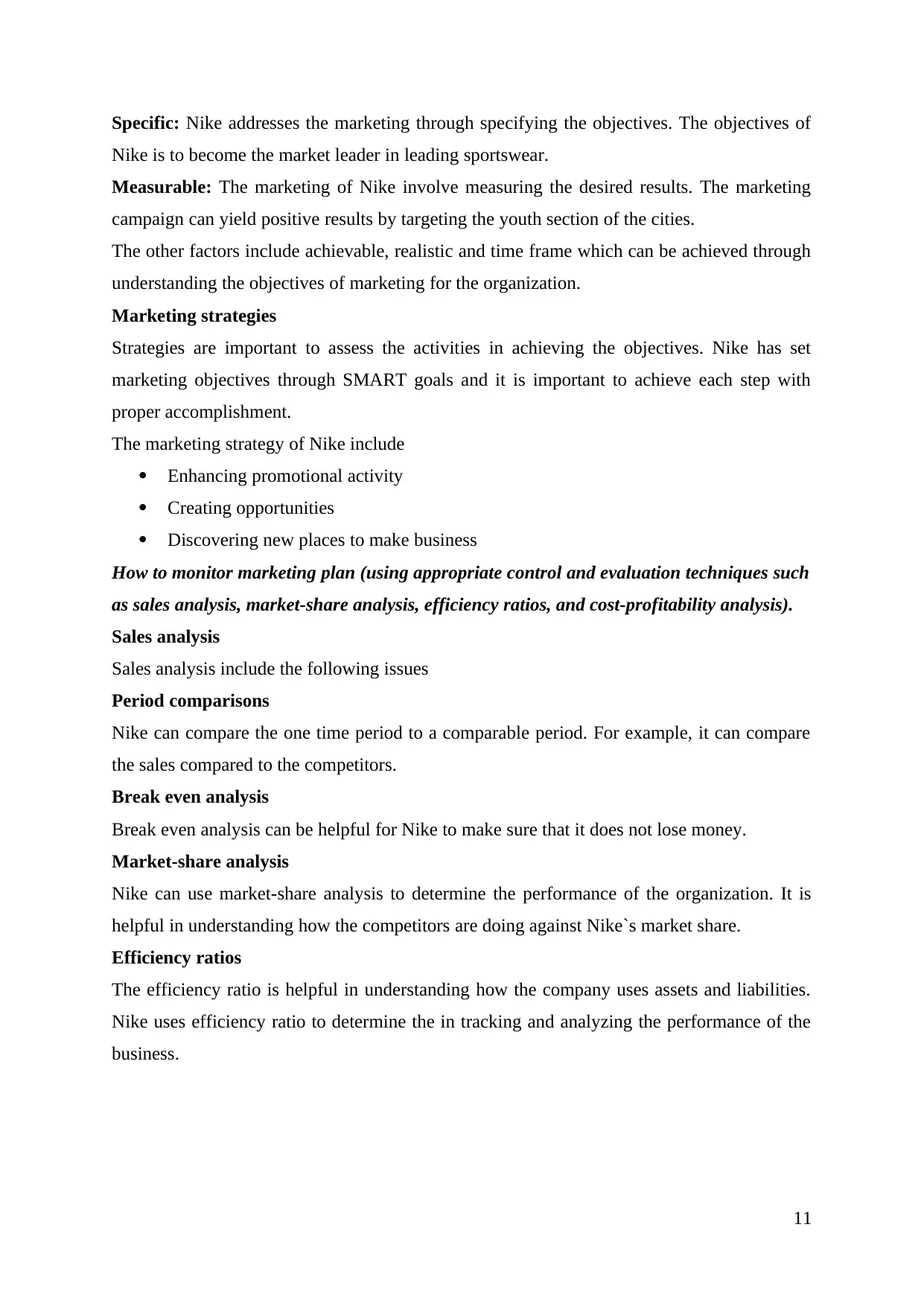
Specific: Nike addresses the marketing through specifying the objectives. The objectives of
Nike is to become the market leader in leading sportswear.
Measurable: The marketing of Nike involve measuring the desired results. The marketing
campaign can yield positive results by targeting the youth section of the cities.
The other factors include achievable, realistic and time frame which can be achieved through
understanding the objectives of marketing for the organization.
Marketing strategies
Strategies are important to assess the activities in achieving the objectives. Nike has set
marketing objectives through SMART goals and it is important to achieve each step with
proper accomplishment.
The marketing strategy of Nike include
Enhancing promotional activity
Creating opportunities
Discovering new places to make business
How to monitor marketing plan (using appropriate control and evaluation techniques such
as sales analysis, market-share analysis, efficiency ratios, and cost-profitability analysis).
Sales analysis
Sales analysis include the following issues
Period comparisons
Nike can compare the one time period to a comparable period. For example, it can compare
the sales compared to the competitors.
Break even analysis
Break even analysis can be helpful for Nike to make sure that it does not lose money.
Market-share analysis
Nike can use market-share analysis to determine the performance of the organization. It is
helpful in understanding how the competitors are doing against Nike`s market share.
Efficiency ratios
The efficiency ratio is helpful in understanding how the company uses assets and liabilities.
Nike uses efficiency ratio to determine the in tracking and analyzing the performance of the
business.
11
Nike is to become the market leader in leading sportswear.
Measurable: The marketing of Nike involve measuring the desired results. The marketing
campaign can yield positive results by targeting the youth section of the cities.
The other factors include achievable, realistic and time frame which can be achieved through
understanding the objectives of marketing for the organization.
Marketing strategies
Strategies are important to assess the activities in achieving the objectives. Nike has set
marketing objectives through SMART goals and it is important to achieve each step with
proper accomplishment.
The marketing strategy of Nike include
Enhancing promotional activity
Creating opportunities
Discovering new places to make business
How to monitor marketing plan (using appropriate control and evaluation techniques such
as sales analysis, market-share analysis, efficiency ratios, and cost-profitability analysis).
Sales analysis
Sales analysis include the following issues
Period comparisons
Nike can compare the one time period to a comparable period. For example, it can compare
the sales compared to the competitors.
Break even analysis
Break even analysis can be helpful for Nike to make sure that it does not lose money.
Market-share analysis
Nike can use market-share analysis to determine the performance of the organization. It is
helpful in understanding how the competitors are doing against Nike`s market share.
Efficiency ratios
The efficiency ratio is helpful in understanding how the company uses assets and liabilities.
Nike uses efficiency ratio to determine the in tracking and analyzing the performance of the
business.
11
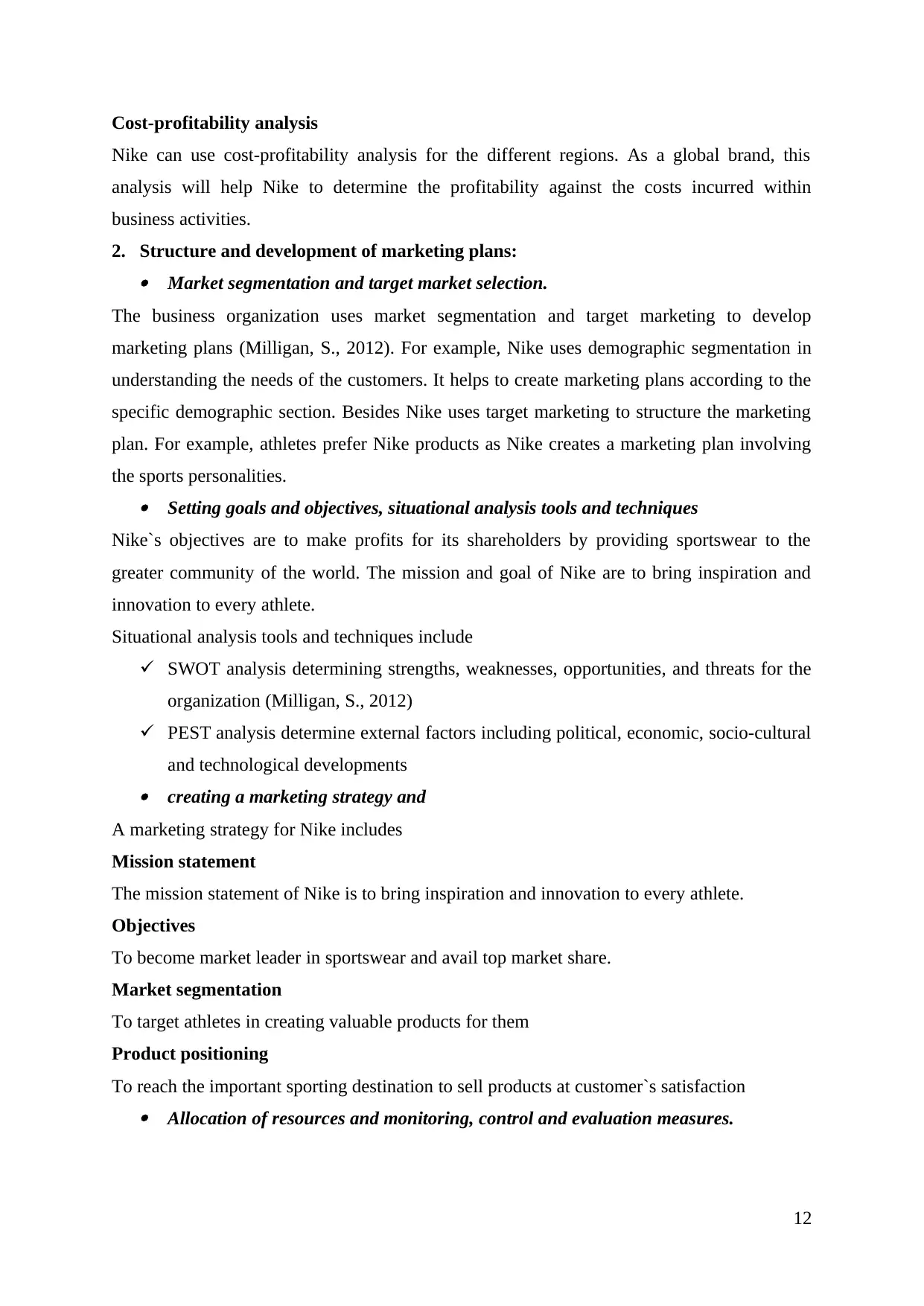
Cost-profitability analysis
Nike can use cost-profitability analysis for the different regions. As a global brand, this
analysis will help Nike to determine the profitability against the costs incurred within
business activities.
2. Structure and development of marketing plans: Market segmentation and target market selection.
The business organization uses market segmentation and target marketing to develop
marketing plans (Milligan, S., 2012). For example, Nike uses demographic segmentation in
understanding the needs of the customers. It helps to create marketing plans according to the
specific demographic section. Besides Nike uses target marketing to structure the marketing
plan. For example, athletes prefer Nike products as Nike creates a marketing plan involving
the sports personalities. Setting goals and objectives, situational analysis tools and techniques
Nike`s objectives are to make profits for its shareholders by providing sportswear to the
greater community of the world. The mission and goal of Nike are to bring inspiration and
innovation to every athlete.
Situational analysis tools and techniques include
SWOT analysis determining strengths, weaknesses, opportunities, and threats for the
organization (Milligan, S., 2012)
PEST analysis determine external factors including political, economic, socio-cultural
and technological developments creating a marketing strategy and
A marketing strategy for Nike includes
Mission statement
The mission statement of Nike is to bring inspiration and innovation to every athlete.
Objectives
To become market leader in sportswear and avail top market share.
Market segmentation
To target athletes in creating valuable products for them
Product positioning
To reach the important sporting destination to sell products at customer`s satisfaction Allocation of resources and monitoring, control and evaluation measures.
12
Nike can use cost-profitability analysis for the different regions. As a global brand, this
analysis will help Nike to determine the profitability against the costs incurred within
business activities.
2. Structure and development of marketing plans: Market segmentation and target market selection.
The business organization uses market segmentation and target marketing to develop
marketing plans (Milligan, S., 2012). For example, Nike uses demographic segmentation in
understanding the needs of the customers. It helps to create marketing plans according to the
specific demographic section. Besides Nike uses target marketing to structure the marketing
plan. For example, athletes prefer Nike products as Nike creates a marketing plan involving
the sports personalities. Setting goals and objectives, situational analysis tools and techniques
Nike`s objectives are to make profits for its shareholders by providing sportswear to the
greater community of the world. The mission and goal of Nike are to bring inspiration and
innovation to every athlete.
Situational analysis tools and techniques include
SWOT analysis determining strengths, weaknesses, opportunities, and threats for the
organization (Milligan, S., 2012)
PEST analysis determine external factors including political, economic, socio-cultural
and technological developments creating a marketing strategy and
A marketing strategy for Nike includes
Mission statement
The mission statement of Nike is to bring inspiration and innovation to every athlete.
Objectives
To become market leader in sportswear and avail top market share.
Market segmentation
To target athletes in creating valuable products for them
Product positioning
To reach the important sporting destination to sell products at customer`s satisfaction Allocation of resources and monitoring, control and evaluation measures.
12
⊘ This is a preview!⊘
Do you want full access?
Subscribe today to unlock all pages.

Trusted by 1+ million students worldwide
1 out of 15
Related Documents
Your All-in-One AI-Powered Toolkit for Academic Success.
+13062052269
info@desklib.com
Available 24*7 on WhatsApp / Email
![[object Object]](/_next/static/media/star-bottom.7253800d.svg)
Unlock your academic potential
Copyright © 2020–2025 A2Z Services. All Rights Reserved. Developed and managed by ZUCOL.





